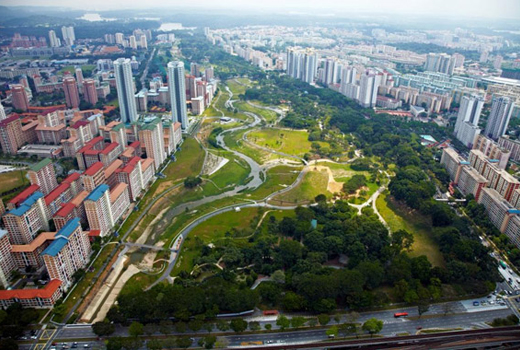CH2M HILL & Singapore’s Canals: Reconnecting People to Water’s Life Flow
The word “canal” evokes many responses from the romance of the canals of Venice to the toxic legacy of the Love Canal. A canal can be a dramatic centerpiece to commerce and history, a forgotten stormwater chute behind buildings or a constructed waterway through arid fields where frogs croak and children learn to swim. In cities throughout the world, canals are either wasted or polluted stormwater gullies, a boon for development and center of urban life or something in-between. Realizing the full potential of urban waterways ultimately creates a treasure for the city as well as an educational centerpiece where people learn to care for natural resources. This transformation involves three steps:
- Restore. Conduct environmental clean-up of the most polluted water areas for the basic protection of health, safety and welfare.
- Redevelop. Create flood protection and riverfront infrastructure that sets the foundation for new investments along its banks and creates prosperity, jobs, lifestyle amenities and recreation.
- Reinterpret. Establish bold public awareness campaigns and demonstration projects at the highest level of sustainable best practices, which significantly change urban perceptions and behavior about water use and its important role.
This progression reflects how water in a city is perceived. Many of these urban waterways were – or are – filled with disease and carry the refuse of occupants and industries. The first order of business is to restore the river to health, which leads to redevelopment. Cities take the lead in creating value and tourist areas as public perceptions begin to shift with clean, refreshed possibilities. At the third level, reinterpretation, perception has completely changed, and the waterway has become a treasure and a destination. The public is educated and engaged in environmental stewardship.
Many cities restore the waterway and redevelop it to prevent or to reduce flooding but then have a hard time moving to the reinterpret phase. Singapore’s journey illustrates how to achieve reinterpretation, allowing their citizens to embrace and respect the water that flows through their city. After years of work, the country has realized reinterpretation with its Active, Beautiful, Clean Waters (ABC Waters) Program. Its Kallang River at Bishan-Ang Mo Kio Park and Alexandra Canal projects have transformed utilitarian waterways into environmental assets and created opportunities for the community to bond with water.
Restore: Protect Health, Safety & Welfare
The Kallang River drains into the Singapore River, which was an open sewer until the 1970s. Waterways collected trash and refuse, creating hazardous and unsanitary conditions. Heavy flooding and property damage followed severe rains. A 10-year clean-up program began in 1977 with the environmental goal of supporting marine life and preventing solid and liquid waste from entering the river. The clean-up program’s social goal was to create new housing and livelihoods for people living along the river.
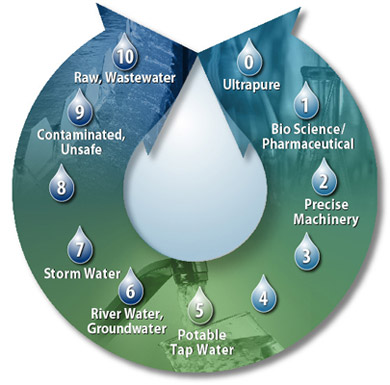
© CH2M HILL | All water has the potential for beneficial use and can move along a continuum from wastewater to ultra-purified.
Cleaning-up the river was significant as it provided the motivation to build a comprehensive sewerage system that serves 100 percent of residents with modern sanitation. By separating sewage from water and rainwater systems, unpolluted rainwater could then be collected in an engineered system of drains and canals, and stored in the reservoirs. Without these improvements, ABC Waters Program would not have been possible.
A key theme emerging in global discussions on water and smart cities is there is no such thing as wastewater. All water should be viewed as having a beneficial use or reuse. This represents a shift in human awareness – one critical for creating vibrant urban waterways. To safely realize water’s intrinsic value, municipalities first need to recognize that water does not have to be perfectly clean to be useful. Water from the tap is not the purest form of water: It is one step along the water continuum from ultra-pure to raw wastewater, which needs cleaning and restoration. Natural treatment options for run-off bring water to a level of cleanliness that is safe for humans and which nurtures biodiversity.
Redevelop: Envision Waterways as More than Canals
As Singapore thrived and moved into the new millennium, its leaders envisioned the need to go beyond the traditional engineering function of stormwater management with their reservoirs, canals and rivers. They wanted to create something sustainable, dynamic and vibrant but still able to handle the increased conveyance capacity required for drainage systems. To do this, the country needed a master plan. The national water agency, PUB, initiated the ABC Waters Program in 2006 to transform Singapore’s network of drains, canals and reservoirs beyond their traditional functions of drainage, flood control and water storage into beautiful and clean streams, rivers and lakes. This forms a seamless blue-green network well-integrated with adjacent land developments, thus creating new community spaces and encouraging new lifestyle activities to flourish in and around the waters.
“Our vision is to transform Singapore into a vibrant city of gardens and water. But we couldn’t pursue this vision without challenging ourselves to look beyond our waterways’ utilitarian functions. We need to unlock the opportunities of our ‘blue network’ as potential areas for fun-filled community activities and aesthetic appreciation,” explained Tan Nguan Sen, PUB director of Catchment & Waterways.
One ABC Waters project is the aforementioned Kallang River at Bishan-Ang Mo Kio Park, which transformed 2.7 kilometers of concrete canal into three kilometers of natural, meandering river with bioengineered slopes and landscaped banks. A first in the tropics, soil bioengineering techniques were used to stabilize river banks and to protect them from erosion so they can withstand strong flood flows. Beyond economic and infrastructure values, the revitalized river teems with life and demonstrated a 30 percent increase in biodiversity even before construction was complete.
Located upstream in the park, cleansing biotopes offer effective water treatment while maintaining a natural and beautiful environment. Biotopes consist of carefully selected plants that help cleanse water by filtering pollutants and absorbing nutrients without chemical use. Water from the river and ponds is pumped into the cleansing biotope, which is then treated by plants like paper reed, water canna and pickerel weed before flowing back to the ponds and eventually cascading back to the river.
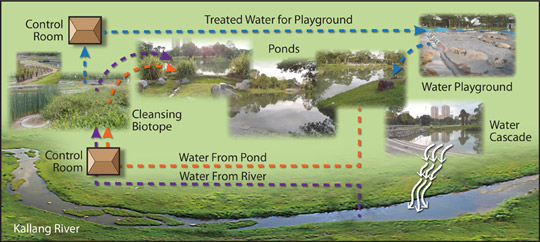
© CH2M HILL and PUB, Singapore’s national water agency | The cleansing biotope at Bishan-Ang Mo Kio Park treats water naturally to the appropriate level for the intended use.
The Kallang River’s drainage capacity was also expanded by creating a floodplain, which provides generous open space for recreational activities. In the case of a heavy downpour, the park functions as a floodplain and allows river water to spread and slow the waters down, thus reducing the river’s hydraulic overload in more dense urban areas downstream. A river monitoring and warning system with water level sensors, warning lights, sirens and audio announcements was designed into the park to provide early warning for impending heavy rain or rising water levels. In addition, warning signs, red markers and life buoys were erected along the river. As the project was constructed, extensive community outreach raised awareness about safety features in place at the park.
“While we want to encourage the community to get close to water, we’re also mindful that public safety should always remain a top priority. Through our outreach program, we explained how this new floodplain approach works and the various safety measures put-in-place. We held a series of briefings and workshops with the local community and at schools to inform the public of the importance of playing safely. Now people view this as more than an aesthetic activity; it is also something that makes their community more secure from flooding,” said Sen.
Building a Foundation for New Investments
More than water flows through a city as a result of a restored urban waterway. Smart water use can become a conduit for new development and increasing property values. Savings from resource optimization, such as reducing demand on engineered stormwater treatment systems by using green infrastructure, can actually create a new revenue stream. This enables cities to fund intelligent transportation, education, innovative core jobs and more with the extra revenue, which enhances a city’s global competitiveness.
The first step is to create a regional value proposition by mapping existing infrastructure. Planners literally begin with an aerial view of the city and identify locations of facilities for energy, water and wastewater treatment, and other utilities, with a date next to each. In most cities, urban planners find nothing connected and infrastructure is out-of-date. Once the base map is created, it then becomes possible to seek opportunities to upgrade and coordinate services to save money. This money can then fund improvement projects like revitalizing waterways that, in turn, supply additional savings to fund future projects. A fundamental principle of smart city development is to establish a foundation of infrastructure and to find efficiencies to lower operational costs. Geographies subject to extreme rainstorms can truly benefit by current smart, urban systems and technologies to capture this precious resource for future use.
Through the ABC Waters Master Plan, PUB identified more than 100 potential locations island-wide for project implementation by 2030 with more than 20 projects implemented by 2012. For planning purposes, Singapore was divided into three watersheds (Eastern, Central and Western) with detailed guidelines drawn up for each watershed. These guidelines are based on the character of the areas studied with attention given to functional and design differentiation, importance of safety and protection of water quality as well as integration with natural systems and biodiversity.
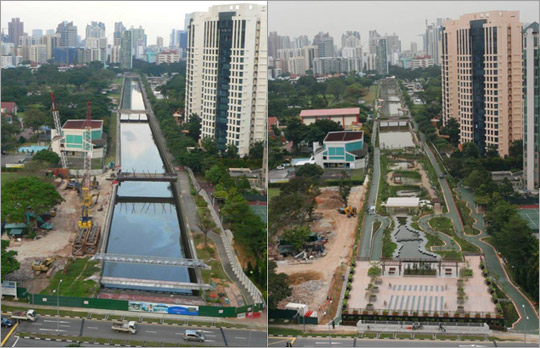
© PUB, Singapore’s national water agency | The Alexandra Canal project before and after.
The Alexandra Canal project shows how to integrate wetlands and other sustainable stormwater management designs into the landscape and waterscape of the urban fabric. In densely populated, land-limited Singapore, development is intense and vertical. The challenge lies in combining high intensity land use and livability. Canals are no longer viewed as pure infrastructure; like the rest of the land, they must do double-duty. ABC Waters projects create new social and community space and meet stormwater functions while also increasing livability and land economic value.
“We are not just investing within the heart of the city but really trying to invest in sustaining the city’s heart – the social elements – at the same time. Our goal was to create rain gardens, bio-retention swales and other urban infrastructure to clean water and, at the same time, to enhance the waterways’ aesthetic qualities. This place must meet critical engineering and safety standards but also put people at the center,” explained CH2M HILL Project Manager Tuck Wai Lee.
Reinterpret: Help Citizens Embrace & Respect Water Resources
Central to the ABC Waters concept is a desire to connect people to water so water becomes a cherished, central resource. In the Kallang River at Bishan-Ang Mo Kio Park project, Lee said people can “witness, first-hand, the transformation of stormwater to clean river water. They can literally watch water go through a series of natural filters, which they can walk up to and experience for themselves. Seeing people learn this way is powerful for me as an engineer.”
To make this happen, people were engaged in both the Kallang River at Bishan-Ang Mo Kio Park and Alexandra Canal projects from the very beginning. The Bishan-Ang Mo Kio Park project redesigned an existing park with a new emphasis: creating opportunities for close interaction with water and the Kallang River that runs along it. The community was involved throughout the design and construction phases. At the Alexandra Canal project, nearby school volunteers planted the wetlands for a series of ponds, which were designed to demonstrate how various natural treatment systems function to improve water quality and to enhance biodiversity.
The wetlands’ educational signage, designed by school children, describes Singapore’s four national water sources. This includes water from local catchment areas, imported water, reclaimed water known as “NEWater” and desalinated water. The signage panels also discuss the concept of water catchments and the importance of keeping waterways clean. The overarching theme is connecting people to their water source. The school subsequently developed curriculum activities using this as an outdoor classroom.
The Bishan-Ang Mo Kio Park project has generated multiple community benefits. Sen said it was “very satisfying to see how the naturalized river has turned the whole park into a more vibrant and beautiful place with people enjoying the waters, biodiversity and new spaces created. This is especially so knowing the whole construction process was holistic and sustainable.”
Recycling materials during construction was part of the sustainable approach. Visitors can view the entire park by climbing Recycle Hill, which was constructed from concrete slabs recycled from the canal when it was demolished. This represents a deliberate effort to preserve a portion of the park’s history and to reuse the concrete in a creative and meaningful way. The park has a range of facilities catering to visitors of all ages, including a community garden, a Riverside Gallery and three playgrounds, each with a distinctive theme. Lawns and open spaces are interspersed throughout Bishan Park, which are available to the public for booking. Activities include foot reflexology, kite flying, jogging, Tai Chi, soccer, photography, picnicking and bringing dogs to the off-leash area.
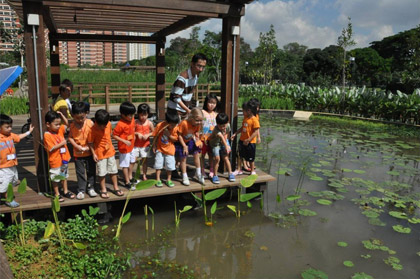
© CH2M HILL | Tuck Wai Lee explains how the wetlands at Alexandra Canal
work to school children.
“No longer separated by a concrete canal, the river and park are now integrated and more accessible to the community. It is very nice to see families enjoying the river, especially during the weekends,” said Sen.
Bishan-Ang Mo Kio Park is a haven for biodiversity and an ideal outdoor classroom. Park visitors can look for a variety of flora and fauna species, including wild maracuja (stinking passionflower), basil, bladder cherry, the scaly breasted munia (Lonchura punctulata), purple heron (Ardea purpurea), little egret (Egretta garzetta), variable wisp (Agriocnemis femina), common scarlet (Crocothemis servilia) and the peacock pansy (Junonia almana).
A+B+C = More than the Sum of a City
Worldwide, urban waterways and canals await society’s attention. In many areas, restoration has begun with cleanup of heavily contaminated waters. In some areas, redevelopment has taken hold as people recognize increased property values and economic benefits of green infrastructure and parkways. In a few areas, cities have chosen to embrace water flowing through their midst and to reinterpret their citizen’s relationship with it. To do this – to bring people back to the river and the value of their watershed – is the ultimate achievement.
“I have known rivers,” wrote Langston Hughes in his poem, The Negro Speaks of Rivers. “I’ve known rivers ancient as the world and older than the flow of human blood in human veins. . . . I looked upon the Nile and raised the pyramids above it.”
Human history and rivers, and later cities and canals, are inseparable. Civilization’s greatest cities were born around rivers. For a time, people chose to channelize, tile over and remake watersheds to manage flow for improved uses. As water flowed from taps and wells, cities literally turned away from the watershed that made living possible. Buildings faced the street, and the backs of those structures were to the river. The first phase of engineering water – controlling, covering and redirecting it to treatment plants – was absolutely necessary to improve sanitation and hygiene in crowded cityscapes.
Now engineering and science have progressed to incorporate cities above and around water in an effort once again to reconnect people to this life flow. Blending science and engineering in green infrastructure creates more than just clean, flowing water, nice parks and biodiversity. Reaching the stage where cities reinterpret people’s relationship with water has the potential to create investment in and concern about global water issues beginning with the water children touch in playgrounds and then expanding to the oceans.

